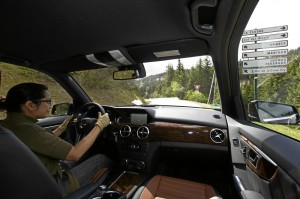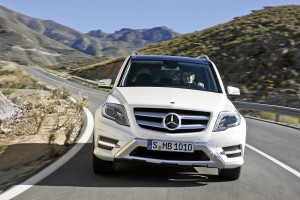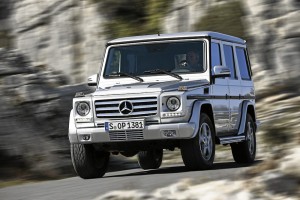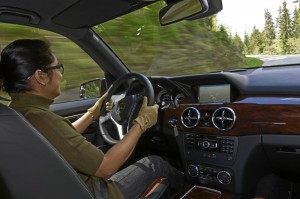Oh my G!

DRIVING round the scenic La Clusaz, France, a ski area, with the new GLK 350 4Matic, which runs on around 17 percent less fuel and has eco start/stop function that comes as standard on all models
First things first, please allow this author to express a “preface” for this story. As a motoring reporter who has been covering the beat for 14 years, there have been many invitations to try this and that car in this or that country. All of these trips, of course, have been exciting, and upon my return to my home country, these have enriched my memories, knowledge and automotive skills. Very rare, however, have been those assignments that have made me giddy with anticipation. This was one of them.
How giddy? Oh, just enough to make me buy a top-of-the-line digital camera because, in the words of Aerosmith frontman Steven Tyler, “I don’t wanna miss a thing.” (Consequently, some of the pictures shown in these pages are taken with Olympus’ new wonder-camera OMD).
How could I say no to an exclusive invitation from the inventor of the automobile itself, to drive some of the world’s most innovative vehicles, on routes that are some of the most picturesque on this planet? How could I say no when the triple-pointed icon of the royal family of automobiles, which has been an integral part of my childhood memories (I vividly remember those jeepneys with “aspirational” Mercedes-Benz logos on their hoods that I rode every day on my way to college. What did I know, then, about the separation of the poor and the rich when it came to cars? I grew up understanding that the logo, and the name it represented, was as accessible to my lowly jeepney driver as it was to the chaffeur-driven landowner), now offered me a free ride to a higher level of understanding about the brand and the company?
Refute me or not, I have come to the realization that Mercedes-Benz is all about endurance. If you’re the oldest car manufacturer in the world, it would be a perfectly reasonable thing to capitalize on, too. There are a lot of examples. There’s Gregorio Sachinidis and his 1976 Mercedes-Benz 240D that logged in 2.85 million miles (over 4.5 million km)—outlasting even the lunar rockets. There’s this couple—George and Luzstella Koschel of Orange County, California—who drove their 1970 280SE Sedan for 1,019,000 miles (1,630,400 km). In a trip to Chiang Mai, Thailand, I was introduced to Boonyarid Chullasapya, a real estate businessman born in 1955, the same year his parents acquired Red Angel (a two-door 190 SL). On the road, driving the Red Angel, he pointed to a tiny space behind the passenger seats where he said he was placed when his parents brought him along for their Sunday drives.
And just recently, the Philippines was visited by 74-year-old globetrotting German Gunther Holtorf, who arrived in April with his diesel-powered SUV, a 1988-model Mercedes-Benz 300 GD he fondly names Otto. Gunther, on his trusty Otto, marked the 800,000th km of their 23-year, 199-country road trip that started in Munich, and ends there sometime in the near future.

THE REVAMPED GLK Class incorporates the integral safety concept in keeping with the Mercedez-Benz’s philosophy
It was quite serendipitous, then, that I would stumble upon Gunther as he was about to embark on his 8,000-km journey across the Philippines, while I myself prepared for a 16-hour flight to Geneva, Switzerland, to test-drive the latest versions of the Mercedes-Benz GLK and G-Class in La Clusaz, France. “Good luck on your drive,” chuckled Gunther a few days before I flew to Europe. “You’ll be a G-specialist in no time.” “Good luck on your drive, too,” I replied, even as the adventurous part of me knew that Gunther was already the luckiest man behind the wheel.
The ‘G-spot’
Not so fast, now. The G-spot I refer to here is about worldly pleasures, yes, but not of the erotic kind. It’s the pleasure of driving Mercedes-Benz’s SUV family GLK and G-Class, and the little pleasant surprises they offer for the driver and passengers. The new edition of its compact SUV, known as the GLK, underlines individual character with a fresh design, innovative assistance systems, as well as efficient, agile engines.
Mercedes-Benz’s cult classic SUV the G-Class—a 4-wheel-drive icon for 33 years (the lineage which Gunther’s Otto belongs)—has undergone a comprehensive update and now offers improved safety and luxury, as well as two new exclusive AMG high-performance models.

THE G-CLASS—which has marked the pinnacle of all-terrain vehicles for the last 33 years—is in its element on mountain slopes. It is now on its umpteenth revival.
After a 16-hour flight from Manila (with a flight transfer at Doha, Qatar), I was billeted at the 5-star Hotel President Wilson in Geneva, Switzerland. En route to the briefing for the international media (only two Asian countries were invited) at Domaine de Choully in Satigny-Choully in Switzerland, we saw the magnificent panorama of the Alps and Lake Geneva.
Lined up at Domaine de Choully were the test units of the GLK 220 CDI 4Matic BlueEfficiency, GLK 220 BlueTEC 4Matic, GLK 250 BlueTEC 4Matic and GLK 350 CDI 4Matic BlueEfficiency. Our two-man Philippine team was issued a fire opal GLK 350 CDI 4Matic. Despite the 35-hp increase, the top diesel model is said to run on around 17 percent less fuel (at 6.9 to 7 km per liter, in European driving conditions). The gasoline-powered GLK 350 4Matic BlueEfficiency features the leading generation of V-engines. All GLK models have 7G-tronic plus transmission.
As shown here, the new GLK combines classic elements of all-terrain vehicles with the design idiom of the latest Mercedes Benz models. Stringent lines, expansive surfaces and the smooth surfaced, volume-emphasizing front and rear areas harmonized with the halmark GLK body features are typical of classic functional all-terrain vehicles. The high seat position has been ideal for this writer during the whole time she drove on the highway and while offroading around Mt. Alps.
While on the way up to Le Grizzly (the offroad hub for the GLK drive experience), snow was falling; at times sunlight would penetrate the overcast skies.

LA CLUSAZ, France becomes an enormous playground for GLK models recently. Mercedez-Benz’s compact SUV offers a broad lineup whether four- or six-cylinder engines, 4Matic or rear-wheel drive, 7G-Tronic Plus or six speed manual transmision.
Sitting in the GLK, I felt the seatbelt tightening by itself. This was something Mercedes-Benz started as part of its presafe system. Presafe is an additional safety system also present in the E class and other models. Safety engineer Dr. Hakan Ipek, who specializes in passive safety for the GLK, described to Inquirer Motoring, “The presafe makes use of the time between a dangerous situation and a possible car crash. When you get into a dangerous situation, like when the car is sliding or you’re doing an emergency brake, the presafe system sets in, and it’s what you feel when the safety belt pulls you back.”
During the more than one hour, 112-km drive to La Clusaz, France, I felt pronounced vibration on the steering wheel. When I asked Ipek about it after the drive, he said that the lane departure system was, thus, functioning perfectly.
“When you’re changing lanes without using the signal indicator, the steering wheel will be vibrating a bit. This is just a warning.” He explained that the lane departure system activates when the vehicle’s onboard computer system thinks that the driver is “distracted,” and as a consequence is dangerously veering from the proper lane. “Its function is to bring you back. It’s not like pulling your steering wheel but it makes the right movement in the moment and helps you bring the car back on track.”
There are assistance systems installed (and also seen in the S and E Class) as standard to enable a further improvement in active safety and driver fitness safety: electric steering with steer control, which supports the driver in unstable driving conditions by triggering an impulse, which can be felt on the steering wheel, prompting counter-steering by the driver in the correct direction, brake assist, which provides additional brake power when emergency braking is detected, and adaptive brake featuring hill-start assist, hold function, brake drying in the wet and priming of the brake system.
40 percent women
The lane departure system prompted me to ask Ipek how many GLK owners all over the world were women. He answered “40 percent.” Given that many women drivers, myself included, tend to multitask even behind the wheel, it makes sense for the car to “warn” them every now and then to keep their hands on the wheel and eyes on the road at all times.
Noticeable were the side-view mirrors with signal color blind spot assist monitoring to notify the driver of the presence of other cars in parallel lanes. This blind-spot monitoring works using radar sensors in the bumpers—in the front, in the back side.
Optional equipment includes the Attention system sensor, which detects if your arm has relaxed a bit too much, possibly signaling that the driver may have gone to sleep.
Other features in the pipeline would be the 360-degree surround view unique to Mercedes Benz. Four cameras—one looking forward, two looking to the side (outside mirrors), and one in the back—combine to provide a bird’s eye view from all angles of the car. Such a feature has not yet been installed in our test units.
Perched high up, not far from the region’s three major lakes, La Clusaz boasts an abundance of powdery snow. On average, it accumulates more than four meters of it each winter. La Clusaz, a ski area, comprises four varied massifs with a range of slopes and natural environments: aerial passes, sunny valleys and forests.
(Next: Offroading the GLK at the French Alps, and riding the G-Class on the Iron Schoeckl)
